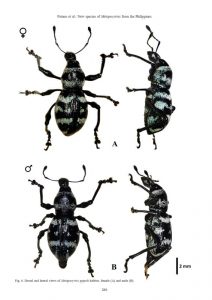DAVAO CITY (MindaNewst) – Two species of snout beetles were discovered in Mt. Hamiguitan Range Wildlife Sanctuary in Davao Oriental, according to the Department of Environment and Natural Resources (DENR)-Davao City.
The new species, Metapocyrtus villalobosae and Metapocyrtus Gapudi, were found in the lowland forest of Mount Kabunulan situated within the Hamiguitan Range in Barangay Surop, Governor Generoso town.

The beetles were discovered by researchers and entomologists from Central Mindanao University in Bukidnon, a research partner of DENR-Davao, and University of the Philippines- Los Banos, including Dr. Victor Amoroso and Romeo Patano Jr.
Their research on the new beetles was published in the Raffles Bulletin of Zoology, a peer-reviewed journal, last August 24. Their co-authors included Alma B. Mohagan, Maria Melanie M. Guaing, and Sheryl A. Yap.
According to their research, the Metapocyrtus villalobosae differs from “all known congeners by having a wider than long rostrum, the presence of blue to light yellow and gold scale markings, and having two distinct longitudinal stripes in the apical half of each elytron.”
The researchers noted that the “pronotal markings are similar to those of Metapocyrtus (Sclerocyrtus) chamissoi Schultze, 1925, but differ in the presence of light yellow to gold scales, the presence of an elongated stripe under the eye on each lateral side, and the presence of two distinct longitudinal stripes in the apical half of each elytron.”
Meanwhile, Metapocyrtus gapudi “differs from all known congeners by the presence of unique patterns of mostly light and dark blue, with some light yellow to white scale markings in elytra, pronotum, rostrum, and abdomen.”
Its legs, the researchers noted, are entirely black.
“Pronotal and elytral markings resemble those of M. (M.) rugicollis Chevrolat and M. (M.) bukidnonensis Schultze, but differ in colouration of scales and legs. Elytral markings also resemble those of M. (M.) polilloensis Schultze, but differ in scale colouration,” the research added.
The researchers believed that there are still many unknown species in “unprotected and unexplored forest and mountain ecosystems of Mindanao.”
The beetles were observed perching on shrub-like plants at 350 to 400 meters above sea level, the researchers said.
Mt. Hamiguitan was inscribed as a UNESCO World Heritage Site on June 23, 2014 and declared as ASEAN Heritage Park on October 21, 2014.
The Mt. Hamiguitan Range Wildlife Sanctuary, declared a protected area under Republic Act 9303, measures 16,923 hectares covering Mati City and San Isidro and Governor Generoso towns.
Mt. Hamiguitan harbors 963 species of flora and 440 species of fauna, 341 of which are endemic to the Philippines.
The plants include 729 angiosperms, 27 conifers, 164 ferns and allies, 17 mosses, 13 liverworts, and 13 lichens.
The known fauna comprise 15 species of non-flying mammals, 11 species of flying mammals, 108 species of birds, 33 species of reptiles, 18 species of frogs, 142 species of butterflies, 31 species of dragonflies and damselflies, 46 species of spiders, four species of earthworms, 15 species of nematodes, and 17 species of freshwater fish. (Antonio L. Colina IV/MindaNews)


